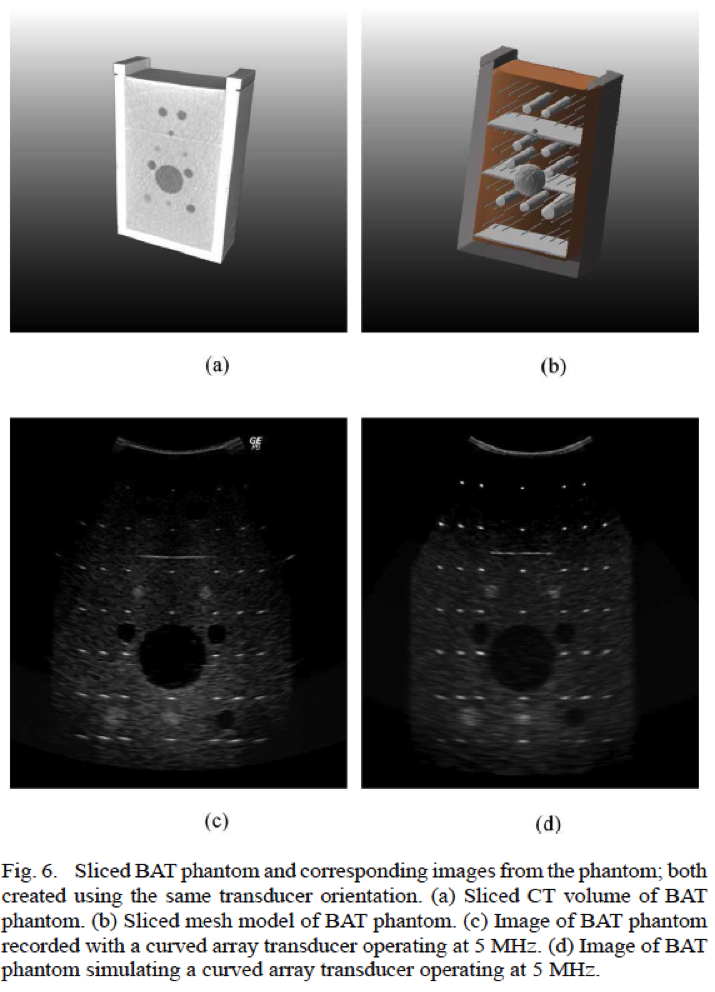Master thesis
Supervision: Ahmad AhmadiAbstract
Medical ultrasound imaging is receiving increasing importance, due to its versatile usability both in pre-operative diagnostics and monitoring, as well as intra-operative navigation and real-time update of the surgical plan. The simulation of medical ultrasound imaging is an important task and has several application areas, such as pre-operative planning and simulation of the surgical procedure, intra-operative registration of a multi-modal pre-operative plan to the intra-operative scene (e.g. involving CT imaging), multi-modal registration (US-CT, US-MRI) as well as visual servoing of robotic ultrasound acquisition. Ultrasound simulation approaches are prone to trade-offs between speed and realism. Very fast approaches based on ray-casting of US images from CT deliver rough approximations of US images, which are useful e.g. for registration in real-time and intra-operatively. In contrast to that, physically realistic simulations based on e.g. models of wave-propagation in human tissue yield images which match the real image closely, but these methods are typically very slow in execution. Convolution-based approaches take an in-between position between the two approaches, allowing for very fast (i.e. real-time) simulation, but offering realistic features such as speckle patterns. This thesis aims at understanding the physical process of ultrasound imaging fully and developing a flexible framework for realistic and fast convolution-based ultrasound simulation. A more detailed description of 1) motivation, 2) task description, 3) objectives in detail and 4) a few pointers to related literature can be found in this PDF document.
Possible quality of convolution-based ultrasound simulation (taken from Buerger et al., 2012, see project description).
(Click on the image to see the fullsize version.)
| Students.ProjectForm | |
|---|---|
| Title: | A flexible framework for realistic convolution-based real-time ultrasound simulation |
| Abstract: | Medical ultrasound imaging is receiving increasing importance, due to its versatile usability both in pre-operative diagnostics and monitoring, as well as intra-operative navigation and real-time update of the surgical plan. The simulation of medical ultrasound imaging is an important task and has several application areas, such as pre-operative planning and simulation of the surgical procedure, intra-operative registration of a multi-modal pre-operative plan to the intra-operative scene (e.g. involving CT imaging), multi-modal registration (US-CT, US-MRI) as well as visual servoing of robotic ultrasound acquisition. Ultrasound simulation approaches are prone to trade-offs between speed and realism. Very fast approaches based on ray-casting of US images from CT deliver rough approximations of US images, which are useful e.g. for registration in real-time and intra-operatively. In contrast to that, physically realistic simulations based on e.g. models of wave-propagation in human tissue yield images which match the real image closely, but these methods are typically very slow in execution. Convolution-based approaches take an in-between position between the two approaches, allowing for very fast (i.e. real-time) simulation, but offering realistic features such as speckle patterns. This thesis aims at understanding the physical process of ultrasound imaging fully and developing a flexible framework for realistic and fast convolution-based ultrasound simulation. |
| Student: | |
| Director: | |
| Supervisor: | Ahmad Ahmadi |
| Type: | DA/MA/BA |
| Area: | |
| Status: | finished |
| Start: | |
| Finish: | |
| Thesis (optional): | |
| Picture: | |